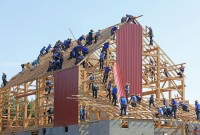- Home
- Business Processes
- Industry Knowledge
- Aerospace Industry
- Automotive Industry
- Banking Domain
- BFSI Industry
- Consumer/ FMCG Industry
- Chemicals Industry
- Engineering & Construction
- Energy Industry
- Education Domain
- Finance Domain
- Hospitality Domain
- Healthcare Industry
- Insurance Domain
- Retail Industry
- Travel and Tourism Domain
- Telecom Industry
- Leadership Skills
- eLearning
- Home
- Leadership
- Leadership & Management
- Definition of Leadership
Definition of Leadership
Leadership has been defined in different ways by different sets of scholars. In very simple terms leadership can be defined as the skill of a person to influence an individual or a group for achievement of a goal in a given situation. One can use different dimensions and perspectives to define leadership. Through the evolution of leadership thought, leadership has been defined in various ways discussed here.
“A leader is one who has followers”; is a too simple a definition and this description does not clearly define what other attributes are associated with leadership. One can use different dimensions and perspectives to define leadership. Through the evolution of leadership thought, leadership has been defined in various ways with following perspectives:
- Group Processes
- Personality Perspective
- Behavioral Traits
- Power Relationships
- Process perspective
- Skills perspective
Definitions of Leadership
According to MacIver and Page Leadership is the capacity to persuade or to direct man that comes from personal qualities apart from office. It indicates the difference between leadership and office. An individual does not become a leader only by occupying an office which carries responsibility. It is a matter of secondary importance that his important office is of assistance to him in his endeavor to become a leader.
According to Philip A. Woods (2005) leadership is not just a set of free-standing actions i.e., it is not a linear process flowing from leader to the follower but it is a collective entity which comprises of the impetus and direction that emerges from the group which is more than the sum of its parts (the individuals) who make up a group or organization. .
Warren Bennis’ definition of leadership is focused much more on the individual capability of the leader. He defined leadership as a function of knowing oneself, having a vision that is well communicated, building trust among colleagues, and taking effective action to realize one’s own leadership potential.
Leadership can also be called the catalyst that transforms potential into reality. The concept of leadership in itself covers all interpersonal relationships that influence the working of' the organization towards achieving its business objectives and growth.
Leadership is the art of influencing others to direct their will, abilities and efforts to the achievement of leader’s goals. In the context of organizations, leadership lies in influencing individual and group effort toward the optimum achievement of organizational objectives.
Keith Davis observes that, “without leadership, an organization is but a muddle of men and machines…Leadership transforms potential into reality. It is the ultimate act which brings to success all the potential that is in an organization and its people”.
Leadership is often defined as the art of influencing others (people) to strive willingly; to do what the leader wants them to do (often to do the mutually compatible objectives) with zeal and confidence.
According to Dayal (1999) leadership is development of people, not the task. A leader creates conditions for the development of individuality and enhancement of inherent capability of individuals.
The leader is the inspiration and director of the action. He is the person in the group that possesses the combination of personality and leadership skills that makes others want to follow his direction.
Leadership focuses on “people” aspect of management and is based on the assumption that organizational effectiveness significantly depends on their motivation, effort and abilities.
According to Pigors, “Leadership is a process of control in which by the assumption of superiority a person or group regulates the activities of others for purposes of his own choosing.”
In 1938, Chester Bernard gave a new definition of leadership and stated that, “leadership is the ability of a superior to influence the behaviour of subordinates and persuade them to follow a particular course of action”.
A recent theorist on leadership, Williams (2005), states that, “leadership is an interactive art in which the leader is dancing with the context, the problem, the faction, and the objective”.
It is encouraging and inspiring individuals and teams to give their best to achieve a desired result.
Leadership is an attribute of the person who is an ideal for the other members of the group.
Leadership is the behavior that affects the behavior of other people, more than their behavior affects that of the leader.
Leaders work with and through people to accomplish goals.
In the 21 Irrefutable Laws of Leadership, John Maxwell sums up his definition of leadership as “leadership is influence - nothing more, nothing less.”
Anyone who acts as a model to others is often called a “leader”.
Leader leads, suggests, orders, and also guides. Other people follow him. We can say that leadership and domination are not the same meaning.
Peter Drucker defined a leader as someone who has followers.
What is the best definition of leadership?
It is difficult to qualitatively define leadership. Leadership involves various dimensions and attributes. A simple definition of leadership is that leadership is the art of motivating a group of people to act towards achieving a common goal. It is a psychological process of providing guidance for followers. To lead is to guide, conduct, direct, and proceed.
Related Links
You May Also Like
-
Managers have to perform many roles in an organization, and how they handle various situations will depend on their style of management. Management styles are the characteristic ways, of making decisions relating to subordinates. These are the strategies, efforts, or direction used by the manager, to create an efficient workplace, to achieve organizational goals. A management style is the method of leadership used by a manager.
-
Behavioral Approach to Management
The behavioral management theory had a profound influence on management by focusing on understanding the human dimensions of work. It is also called human relations movement as behavioral theorists focused on managing productivity by understanding factors of worker motivation like their needs and expectations, personality, attitudes, values, group behavior, conflict, and group dynamics. It advocated the use of psychological techniques to motivate employees.
-
Theory Z also called the "Japanese Management" style is a leadership theory of human motivation focused on organizational behavior, communication, and development. It assumes that employees want to enter into long term partnerships with their employers and peers. Offering stable jobs with an associated focus on the well-being of employees results in increased employee loyalty to the company.
-
Management Principles by Fayol
Henri Fayol (1849-1925), a French industrialist and a prominent European management theorist, developed a general theory of management. Fayol outlined the fourteen principles of management.
-
What are the functions which a leader does to establish as a leader? What are the activities undertaken by them to become great leaders, rather revolutionary leaders? The most important tasks done by a leader in all situations are defining the vision, mission, and goals, leading the team, administrative functions, motivating followers, decision making and conflict resolution, and continuous development.
-
Hawthorne Studies - Leadership
The Hawthorne studies were conducted on workers at the Hawthorne plant of the Western Electric Company by Elton Mayo and Fritz Roethlisberger in the 1920s. This study established the behavioral change that happened due to an awareness of being observed, resulting in active compliance with the supposed wishes of researchers, because of special attention received, or positive response to the stimulus being introduced.
-
Have you ever resonated that there seem to be as many different ways to lead people as there have been great leaders? When we recall the success of Mahatma Gandhi, Nelson Mandela, Abraham Lincoln, Napoleon Bonaparte to Steve Jobs and Jack Welch, we also notice that they all used different approaches that were suitable to their specific situations and circumstances. Over the last century, researchers and psychologists have developed simple ways to describe the “Styles of leadership” and in this section, we will explore these commonly known leadership styles.
-
The best career choices are ones that match your values. Each person has several values that are important to him. These values are highly personal and knowing them provides a clearer sense of what's most important to you in your life and career. Career values are the beliefs you consider important from a work standpoint. Values help you understand what you want from a job? Explore a few examples of work values that can influence career path and job satisfaction.
-
Teams are part of the modern organizational culture. Whether you are a team leader or a team member, having a better understanding of how teams work, and being able to identify where the team is in the process, is a critical part of ensuring the team is ultimately successful. Start with the basics and understand what a team is and what role they play in an organization.
-
Principles of management are fundamental concepts and advisory guidelines for managerial decision making. By using management principles, managers can more easily achieve the objectives and avoid making mistakes in their activities. Management principles can be applied to any kind of organization and to managers at all organizational levels.
Explore Our Free Training Articles or
Sign Up to Start With Our eLearning Courses

About Us
Learning
© 2023 TechnoFunc, All Rights Reserved










